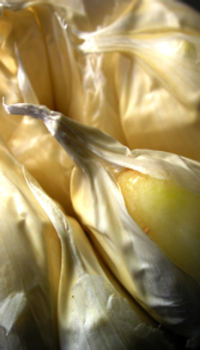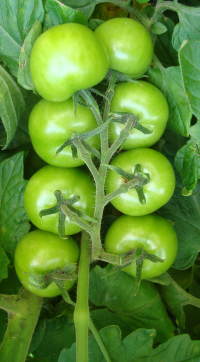
One thing that keeps me happy over winter are my bonsai rocket gardens. Leaving the house for work when it’s dark and getting home in the some disposition, doesn’t allow time for garden therapy. So I’ve been bringing it inside. I spread them on to paper towels on an ice cream container lid, sprinkle water over it once a day and here in winter it usually takes 4 – 6 days to have yumminess. Then I just use them in everything.
High in nutrients and vitamins A, B, C and E, rocket (Eruca spp.) rocks over winter. The sprouts add a nice bit of warmth to any vegetable dish. I use them as a side vegetable for just about anything, sprinkle them on my tomato soup, add them to cheese sandwiches.

Entrachyadids are a type of earthworm, and not a nematode as I first feared. They are a sign that the soil is too acid which is a result of putting in too many kitchen scraps. Although, the entrachyadids don’t do any damage, we will be adding lime to the beds to reduce the acidity.

I have to admit, I’ve become a little obsessed by these beautiful beds, all curved and mounded in sweeping lines. I also love the very way they are constructed, in sort of gentle sweeping movements. Due to my terrain I’m not able to do them at my house, so I’ve been eyeing up other people’s gardens to work on.
Anyway, here are notes on the video including links to some other pieces on Emilia…
Emilia Hazelip – Synergistic Gardening
Based on work of Masanobu Fukuoka, The One Straw Revolution. 1978. Rodale.
Need to modify systems to our own location. Want to get high-yields whiile maintaining the soil’s own fertility.
No cultivation
No chemical or organic fertilisers
No chemical treatments
No compaction of the soil
Set out beds with sticks and then clear paths for your feet, mounding the soil into beds. Mounds should be 4 feet wide with 20 inches for the path. 10 – 30 inches for the beds deeper the beds the more room for the roots. Give them any shape you wish but make sure you can reach the centre of the beds easily.
Sheet mulch – cover the ground with cardboard. A good way to clear ground and you can grow potatoes at the same time.
Plants synthesise from light. Plants only take 2.5% of their mass from the soil. The rest comes from air and light. Plants give back much more to the soil then they take out.
Use marigolds all through the garden.
Beans and peas are legumes and fix nitrogen into the soil. You can use ash, which contains potash, to help grow your beans. This provides free fertiliser for your soil, the bacteria providing many benefits to your plants. These plants will also provide a living mulch between your plants. After harvest, the plants can simply be cut off, leaving the roots in the soil. the plant matter can simply be left on top of the beds. providing further mulch.
Synergistic gardening uses compost in the greenhouse or flats to start the plants – it doesn’t ‘force feed’ your soil with it.
Onions, garlic and leeks can be planted on the side of the garden beds. They function as pests controllers as well as being nutritious. They can be intermixed with other plants like lettuce or swiss chard.
Many plants reseed themselves – an advantage of letting plants finish their life cycle.
Mulching the mounds – Newspaper, cardboard, straw, leaves, wool. You can use grass clippings as mulch, but make sure you cut it and let it dry before it starts to seed. The first year the soill will be eating the mulch but as the organic contents in the soil improves, the amount of mulch needed will reduce. You will still need to weed, but it will gradually reduce – it’s all part of the evolving cycle.
Ducks (Indian Runner ducks), some birds, hedgehogs, lizards all eat slugs. Copper cuffs, or ones made from coke cans can protect plants from slugs.
When harvesting plants like lettuce, cut above the ground allowing the plant a chance to regrow, or providing dead matter for the soil to feed on.
Don’t stand on your beds! this will damage and compact the soil
Flowers are very important as they may attract beneficial insects, secrete chemicals to protect other plants (eg marigolds), or have edible, medicinal, or economic benefits as well as looking very attractive.
Diversity = a healthy, rich soil. Plants lots of plants with different root structures and leave those root structures in the soil when you harvest. Emilia says that force feeding your soil will create an imbalance or indigestion – let things work naturally – synergistically.
In nature, nothing happens in exactly the same way twice in the same spot. Diversify.
More information
The Synergistic Agriculture of Emilia Hazelip at the Fukoka Farming website

Plangarden’s three part series first takes you through knowing your plant families to some common blunders. Followed up by a comparison of companion planting guides, all in handy pdf or snazzy slideshows. It’s great stuff, a handy reference with plenty of commonsense:
“credible sources like Cornell University’s Dept. of Horticulture, enjoin gardeners not to hang on to every word found in a CP guide as providing foolproof solutions. Experts encourage us to frequently check our plants (go ahead, look under the leaves!) and document observations from our own plant combinations.”
So read up, experiment, and hopefully all your plants will be zinging along with synergistic vigour soon.

My particular favourite is:
Lesson 5: The plant diversity of your lawn and gardens is directly correlated with your IQ. This goes without saying, and it explains why lawn monoculturalists are so difficult to teach.

Those of us in the Southern Hemisphere need to be planning our garlic crops now. It’s super easy to grow but you need to have your beds ready and you need to get your cloves to plant. Don’t plant the stuff from the supermarket, it’s too dry and just won’t sprout. Get in to your garden centres quick! Last year wasn’t a great garlic year so everyone will be racing in to buy bulbs.
Traditionally, garlic bulbs go in on the shortest day but a few weeks early will give them a good boost. Remember, garlic stays in the ground for 6 months so you need to think carefully about where you want it. You can plant into pots if you aren’t sure where you’re going to be that far out.
I love simple, cheap and appropriate ideas that make gardening easier and fun. At the first Seedy Sunday we showed three videos with this philosophy in mind.
My two previous attempts at worm farming had ended badly with the bins being overrun with nasties that killed off the worms. But I so love the simplicity and ease of this idea I’m going to give it another shot. This is a great way to get nutrients straight into your garden.
[youtube=http://www.youtube.com/watch?v=scUTrypzyY0&hl=en&fs=1]

Using old guttering provides the perfect depth for lettuce, spring onions, radishes, some cute little Parisian market carrots and most of your herbs. It’s easy maintenance and a great way to recycle.
How does your garden grow? (Juneau Empire via Make)
(via Lifehacker)

Upside-down tomato plant hanging contraptions have been hanging around for years and I’m a bit skeptical. bit skeptical. I’ve heard lots of people marvel over them but I’ve not seen a pic of the plants actually growing in them. The only pics I’ve seen have clearly been taken for advertising purposes when the plants are in full fruit. Do upside down tomato plants work?
My heart always goes “Oooo, that looks nice”. But my head goes, “but what about the auxins?” Auxins are hormones that control aspects of plant growth – things like the flowering, fruiting, bulb formation, dormancy etc.
More on auxins after the jump, along with links to how to test these mad ramblings…

